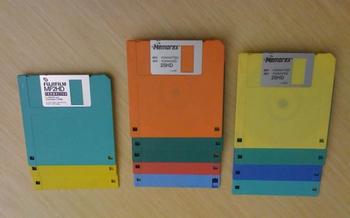Blogs across the Smithsonian will give an inside look at the Institution’s archival collections and practices during a month long blogathon in celebration of October’s American Archives Month. See additional posts from our other participating blogs, as well as related events and resources, on the Smithsonian’s Archives Month website.
For over a decade now, I've been responsible for appraising records and personal papers. This is the process by which archivists determine what materials should become part of the permanent collections of the archives. At the Smithsonian Institution Archives, our decisions are based upon our collection policies, records disposition schedules, and deeds of gift. Before we make these decisions though, we need to learn more about the materials in question, either by getting more information from the owner or creator, or by physically examining the materials.
In the past, a physical inspection of records often meant entering an office, file room, attic, or basement, and opening drawers and boxes. While appraising records, I would sometimes make piles of the materials that should be transferred to the Archives, materials that should be destroyed, and materials that I had more questions about. Sometimes I would also use post-it notes to label everything. To learn more about the materials, all I needed to do was to look at folder or box labels and thumb through some of their contents. Someone who was familiar with the records would often be there to help answer questions.
Over the last few years though, I've been asked to appraise electronic files with increasing frequency. Suddenly, I'm not perusing filing cabinets but sitting in front of a computer systematically clicking through folders. Or I'm putting disk after disk into a drive. Files are not always intuitively named, particularly if they were created at a time when file names could only be eight character long. This results in me needing to open the files to see what they are, but compatible hardware and software are not always immediately available. An organized folder structure allows me to make educated guesses about the contents of the files, but it's not uncommon to find a single generic folder to which all of the files have been saved.
 I was recently asked by a donor of personal papers if we wanted any of the files on an old laptop. I brought Lynda Schmitz Fuhrig, our Electronic Records Archivist, with me to assist in the process of transferring the files to our own servers. When we arrived, the first thing we found was a pile of 3.5" floppy disks. Although they were labeled, I still needed to bring them back to the office in order to verify their contents.
I was recently asked by a donor of personal papers if we wanted any of the files on an old laptop. I brought Lynda Schmitz Fuhrig, our Electronic Records Archivist, with me to assist in the process of transferring the files to our own servers. When we arrived, the first thing we found was a pile of 3.5" floppy disks. Although they were labeled, I still needed to bring them back to the office in order to verify their contents.
We then tackled the laptop. Initially it appeared that there was very little of interest to the Archives. The "My Documents" folder and "Desktop" primarily contained files of a personal nature. It wasn't until we checked the C:\ drive that we found two folders of professional documents, each with layers upon layers of subfolders. During a cursory examination of the files, I did not identify any files that were clearly outside the scope of the deed of gift. Knowing that the transfer of the files would take a long time, I opted to transfer the folders in their entireties and do a more thorough appraisal later.
The laptop was very slow and as Lynda began to prepare the files we realized that the transfer process was going to require hours. We ultimately decided to bring the laptop back to the office to complete the transfer. We didn't know until later that there was 6 GB of data saved to those two folder structures (the laptop was having trouble calculating their sizes).
There are still several more steps that need to occur in the appraisal process. I need to look more closely at the contents folders to determine whether there are certain subfolders that do not meet our appraisal criteria. We also need to compare these files with those previously transferred to the Archives from the donor. Lynda will run programs which will find duplicates among the electronic records. I will be comparing the recently transferred files with the finding aid for the existing paper records to determine where there may be significant overlap.
Appraising paper records is not always easy, but a quick look can often tell me a lot about them. Appraisal of electronic records, however, relies heavily on available hardware and software and just tends to require a lot more time.
Today is the second annual Day of Digital Archives. The Day of Digital Archives has been created to raise awareness of digital archives among both users and managers. By collectively documenting what we do, we will be answering questions like: What are digital archives? Who uses them? How are they created and managed? Why are they important? For more information, see the project's blog.
Related Resources
- Day of Digital Archives, blog
- Smithsonian Institution Archives' Appraisal Methodology, PDF
- A Peek Into an Electronic Records Archivist's Toolbox, The Bigger Picture Blog, Smithsonian Institution Archives
- To Preserve or Not to Preserve: Social Media, The Bigger Picture Blog, Smithsonian Institution Archives
Produced by the Smithsonian Institution Archives. For copyright questions, please see the Terms of Use.

Leave a Comment